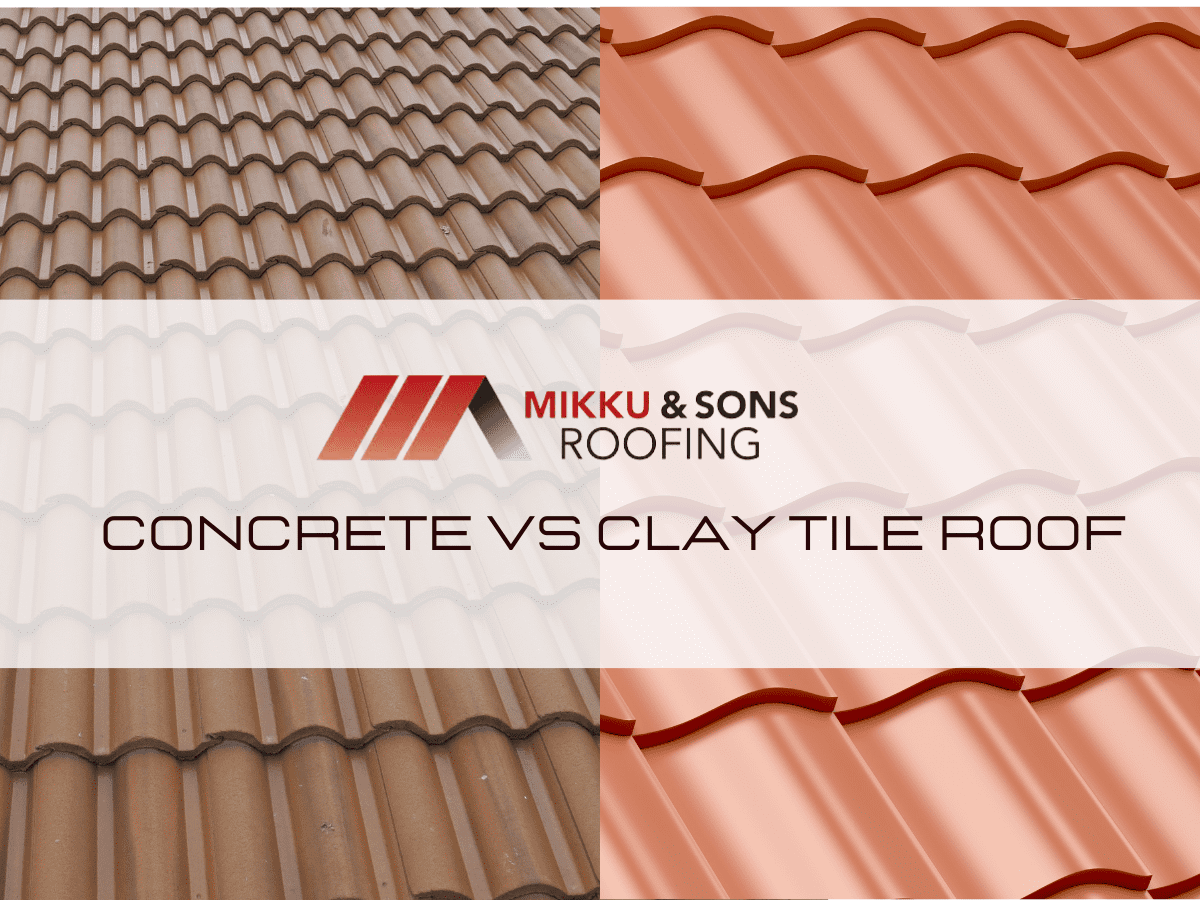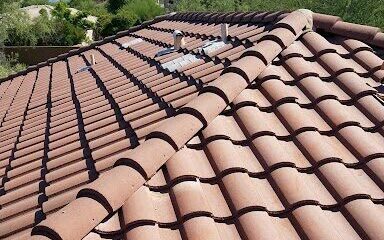

Picture this: you're sipping a cup of coffee in your living room as the rain gently taps on your roof above. Suddenly, you hear a loud crash from above, and then water starts pouring through the ceiling.
You take a look up and notice that your roof has finally caved in. Yikes! Now you have to decide whether to replace your aging roof with clay tiles or with something more up-to-date, like concrete. Yes, it's a difficult concrete vs clay tile roof choice, but have no fear!
We're here to help you make a smart choice that will not only protect your home but also make it look better from the exterior. If you're trying to decide between a clay roof and a concrete roof, this essay can help you make an informed decision.

Do you find yourself drawn to the traditional beauty of a tiled roof for your home? If that's the case, you should look into purchasing clay tiles for your roof.
These tiles have been in use for centuries, giving them a rich heritage that dates from ancient times. Homeowners love clay tiles for their durability, variety of colors, and one-of-a-kind appearance.
So, what exactly are clay tiles, and why are they so popular?
They are made from natural clay, shaped, and burned at high temperatures to provide a strong and long-lasting roofing material. First, the clay is extracted from the ground, and then it is processed to eliminate any unwanted particles, like rocks or sticks.
After that, it gets combined with water and other ingredients to form a clay that can be molded. Once the mixture is ready, it is shaped into the tile's final form and set aside to dry.
After being shaped, the clay tiles are burned at high temperatures to make a tough and long-lasting roofing material. The clay tiles' signature red or orange hue comes from the firing process, which also renders them weatherproof.
Clay roof tiles can be found in a wide spectrum of colors, from the more classic red and orange to the more contemporary green, blue, and gray. The tiles' final color is affected by numerous variables, including the clay they were made from and the temperature of the firing process.
Clay tiles can also be found in a number of different forms and styles, from the classic S-shaped tile to the more contemporary flat or curved tile. By offering such a wide selection of sizes, shapes, and designs, tile companies give homeowners more opportunities to improve the aesthetic value of their homes.
Clay roof tiles have a strong reputation for lasting for many years. If properly cared for, they have a lifespan of 100 years or more, making them a wise choice for homes in need of a durable roofing material.
Clay tiles are fireproof, windproof, and watertight, making them a great roofing material for residences in high-risk climates. They also have a high resistance to decay and insect damage, which can add years to their useful lives.
Roofs made from clay tiles last a long time and have a low impact on the environment. They are constructed with renewable resources that may be found in abundance worldwide.
They're great insulators too, so that helps cut down on utility bills and environmental impact. Also, clay tiles are safe for both homes and the environment because they don't include any chemicals or contaminants.
Keeping clay roof tiles in good condition calls for consistent maintenance. Periodic cleaning is necessary to eliminate dirt, moss, and other organic buildups that can occur on the tiles.
Once a tile becomes cracked or broken, it should be replaced immediately to avoid further problems caused by water.

As a homeowner on the market for a new roof, you may feel confused by the numerous options available to you. You have to decide whether to use asphalt shingles, metal, or another material.
In any case, concrete roofing tiles might be the answer you didn't even realize you needed. Concrete roof tiles have become increasingly common in recent decades.
They are manufactured by shaping a cement, sand, and water combination into the required form, and then curing the material to make it hard and waterproof for use as a roofing material.
Concrete tiles are a versatile roofing material since they can be made in a wide variety of forms, sizes, and colors to suit a wide range of architectural styles and personal tastes.
Concrete roof tiles can be found in a broad variety of colors and designs, from the more conventional red and orange to the more contemporary green, blue, and gray. They can be styled to seem like clay tiles or slate to complement existing roofs.
Concrete tiles can be purchased in a wide variety of forms and styles, from flat to curved to interlocking. As a result, homeowners can find a tile that complements their home's aesthetic while also adding to its value.
Concrete tiles are widely regarded as the most resilient and long-lasting option for roofing. They are a wonderful option for homeowners who want a roof that will last for at least half a century with minimal upkeep.
Concrete tiles are a wonderful option for residences in high-risk areas due to their resistance to fire, wind, and water damage. They also have a high resistance to decay and insect damage, which can add years to their useful lives.
Concrete tile roofs last decades and reduce waste because they are weather- and fire-resistant. They reduce heating and cooling energy by insulating the building. Concrete tiles can be recycled as tiles or aggregate for road bases, landscaping, and other construction materials.
However, manufacturing concrete tiles consumes a lot of energy and releases carbon dioxide and other pollutants, which contribute to climate change and air pollution. They require a lot of water to make, which strains local water resources and ecosystems.
Maintaining the quality of concrete roof tiles calls for consistent care and attention. The tiles need to be cleaned on a regular basis so that dirt, moss, and other organic buildups may be removed.
A tile that has been fractured or cracked should be replaced immediately to avoid further problems due to water leakage.
Concrete and clay tiles are two of the most well-liked roofing materials available.
There are advantages and disadvantages to both materials, but there are also some important distinctions to keep in mind.
The weight differential between concrete and clay tiles is one of the most noticeable distinctions between the two materials. When compared to clay tiles, which weigh on average around 600 pounds per square, the weight of concrete tiles is significantly higher at around 900 pounds per square (100 square feet).
Thus, the installation cost of concrete tiles may rise if extra structural supports are needed.
There are a variety of sealants available for use on both concrete and clay tiles to prevent damage from moisture. There is a need for periodic reapplication of the sealant applied to the surface of concrete tiles to prevent water damage and deterioration.
Sealing clay tiles, on the other hand, can be done with an impregnating sealer that penetrates the tile and extends its lifespan.
There are some key differences to keep in mind while installing either concrete or clay tiles. Screws or nails are used most often for installing concrete tiles, whereas mortar or adhesive might be used for clay tiles.
The additional time and effort needed to install concrete tiles is a potential drawback of this material.
Despite their similar durability, concrete tiles are much less likely to crack or break than clay tiles. This is due to the fragility of clay tiles, which can be damaged by impacts too great, such as those caused by falling tree limbs or hail.
The weight and density of concrete tiles make them much less prone to break or chip.
Whether you choose concrete or clay tiles, you will eventually need to tend to them and possibly repair them. Yet, maintenance and repair requirements can be of varying natures.
Clay tiles should be replaced if they crack or break, but concrete tiles can be resealed or patched on occasion.
Because of their increased permeability, clay tiles are more prone to water damage than their concrete counterparts. Water can seep into the material and accelerate its deterioration if the seams aren't sealed properly.
Meanwhile, concrete tiles are more resistant to water damage because they are less porous.
Clay tiles may be more sensitive to salt intrusion if you reside in a region with high quantities of salt in the air, such as near the beach. Over time, this can cause the tiles to become brittle and lose their original color. Saltwater infiltration is less likely to damage concrete tiles.
Clay tiles may develop efflorescence, a white powdery substance caused by mineral accumulation. It may not cause any damage to the tiles, but it certainly detracts from their aesthetic value. It's less common for efflorescence to occur in concrete tiles
Both concrete and clay tiles come in a range of colors and styles, but there are some differences in their long-term appearance. Concrete tiles may fade over time due to exposure to sunlight, while clay tiles may retain their color for longer.
Concrete and clay tiles, respectively, are both extremely long-lasting and durable, often lasting 50-100 years or more. Yet, because of their resistance to ultraviolet (UV) damage and weathering, clay tiles may have a modest advantage in durability.
Extreme weather conditions, such as high winds and heavy rainfall, are no match for either concrete or clay tiles. Concrete tiles, however, may prove more long-lasting than their clay counterparts due to their greater weight and density.
There is a wide difference in pricing for both concrete and clay tiles from different manufacturers and roof sizes. Concrete tiles are often less expensive than clay tiles, but the cost of adding the necessary support systems can mount up quickly.
Concrete roof tiles:
Clay roof tiles:

Concrete Vs Clay tiles
Roofing tiles made of clay and concrete each have their own set of benefits and drawbacks. Clay tiles have been used for centuries because of their durability, beauty, and resilience to fire, water, and other natural disasters.
Although they are more beautiful, they are also more delicate and need more upkeep. As an alternative, concrete tiles are more long-lasting and need less upkeep, although they may fade in color and are heavier.
The final decision between these two roofing options should be based on the homeowner's specific requirements, financial constraints, and aesthetic choices.
Homeowners can make a well-informed selection about a roofing material that serves their needs and those of the home's aesthetics by comparing the advantages and disadvantages of several options.
